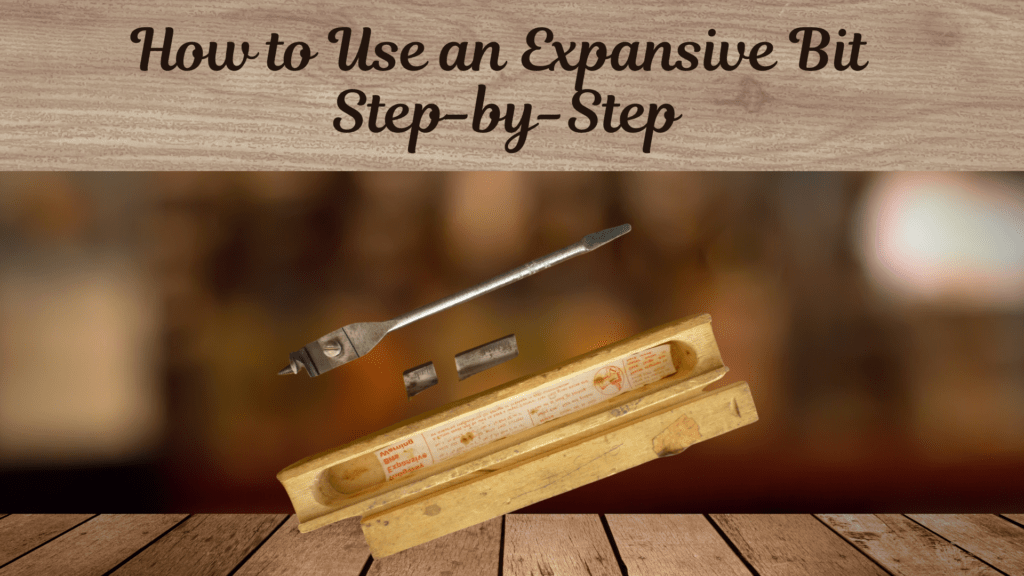
Drilling large or unusual-sized holes in wood can be tricky, especially if regular drill bits don’t work for the size you need. That’s where the expansive bit comes in. This classic tool gives woodworkers the ability to drill different-sized holes using just one bit.
In this simple guide, we’ll explain what an expansive bit is, how it works, its pros and cons, and how to use and care for it properly.
What Is an Expansive Bit?
An expansive bit (also called an adjustable bit) is a special kind of drill bit made for drilling holes of different sizes in wood and other soft materials like plastic or drywall.
The most important part of the tool is its adjustable blade—a small cutter that slides in or out to change the size of the hole. This means you don’t need to buy lots of different drill bits. It’s a smart and flexible tool to have in your toolbox.
Key Components
Central Pilot Drill: Guides the bit and keeps it centered as you bore.
Adjustable Cutter: The main cutting blade, which can be moved to set the hole diameter.
Scale or Gradations: Markings on the bit or cutter to help set the desired size.
Retaining Screw: Locks the adjustable cutter in place once set.
Spur or Spurs: Cut the edge of the hole for a cleaner finish, similar to auger and spade bits.
How Does an Expansive Bit Work?
Expansive bits work like a mix of an auger bit and a spade bit. The pilot screw in the center starts the hole and helps keep the bit in place, while the adjustable cutter removes wood to the size you set.
The process takes more time and effort compared to using a regular drill bit, especially for larger holes, but the advantage is the ability to adjust the size as needed.
Typical Size Range:
Most expansive bits can bore holes from about 20mm to 75mm (roughly 3/4″ to 3″) in diameter, depending on the model.
Some models come with two cutters for different size ranges, further expanding their versatility.
Also read:
Power of Hide Glue in Woodworking
Wet Sanding Wood: A Complete Guide for Perfect Finishing
When and Why to Use an Expansive Bit
Advantages
Versatility: One bit covers a wide range of hole sizes, perfect for custom or non-standard requirements.
Cost-Effective: Eliminates the need to buy and store multiple large-diameter bits.
Custom Fit: Ideal for tasks like fitting vices, running cables, or boring clearance holes where precise diameter isn’t always critical.
Specialist Applications: Useful for restoration, traditional woodworking, and situations where modern hole saws or large bits are unavailable or impractical.
Limitations
Effort: Boring large holes (especially over 1.5″ or 40mm) requires considerable manual force, especially with a hand brace.
Accuracy: Some expansive bits have approximate gradations; always drill a test hole to verify size before committing to your workpiece.
Finish: The cut may not be as clean as with a dedicated Forstner or hole saw bit, especially in hard or brittle woods.
Outdated: With the affordability of modern bit sets, expansive bits are less common and now considered specialist tools.
How to Use an Expansive Bit: Step-by-Step

Set the Diameter
- Loosen the retaining screw and slide the cutter to the desired width using the built-in scale or a ruler.
- Tighten the screw securely.
Attach to Brace or Drill
- Expansive bits typically have a tapered square shank for use in a hand brace, or a hex shank for power drills.
- Secure the bit in your brace or drill chuck.
Drill Slowly and Steadily
- Begin boring at a slow, steady pace. Expansive bits work best at low speeds to prevent overheating, motor strain, or the bit digging in too aggressively.
- Use firm, even pressure. For large holes, be prepared for a workout—these bits require muscle, especially in hardwoods.
Prevent Tear-Out
Drill until the pilot screw just breaks through the opposite side, then flip the workpiece and finish from the other side. This prevents splintering as the cutter exits the wood.
Check and Adjust
For precision work, always drill a test hole in scrap to check the actual diameter and adjust as needed.
Expansive Bit vs. Other Large-Hole Bits
| Feature | Expansive Bit | Hole Saw | Forstner Bit | Spade Bit |
| Adjustable Size | Yes | No (fixed size) | No (fixed size) | No (fixed size) |
| Cleanliness of Cut | Moderate | Good | Excellent | Moderate |
| Effort Required | High (manual) | Moderate (power) | Moderate | Moderate |
| Flexibility | High | Low | Low | Low |
| Typical Use | Custom/odd sizes | Large, standard | Flat-bottom holes | Rough holes |
Maintenance and Care
Clean after each use: Remove wood chips and dust with a brush or cloth.
Sharpen as needed: Use a file to keep the cutter edge keen.
Oil metal parts: Prevents rust and keeps moving parts smooth.
Store dry and organized: Hang on a rack or keep in a dry toolbox to avoid damage and corrosion.
Frequently Asked Questions
1. What materials can an expansive bit drill through?
Expansive bits are designed mainly for wood and soft materials. For harder materials, you’ll need a specialized drill bit.
2. Can expansive bits be used for all types of drilling jobs?
While versatile, expansive bits are most effective for larger hole sizes in softer materials, not for fine drilling or drilling in hard substances.
3. How do you sharpen an expansive bit?
You can sharpen an expansive bit with a sharpening stone or file, focusing on the cutting edges to restore its sharpness.
4. Is an expansive bit suitable for DIY projects?
Absolutely! An expansive bit is perfect for DIY projects where you need to drill a range of hole sizes without changing bits.
5. What are the main differences between a standard drill bit and an expansive bit?
A standard drill bit is fixed in size, whereas an expansive bit is adjustable, allowing for various hole sizes with one tool.
Final Say
The expansive bit is still a useful tool for woodworkers who need to drill large or custom-sized holes. It may not be as fast or smooth as modern drill bits, but its ability to adjust to different sizes makes it a smart and affordable choice for special jobs.
With the right setup, careful use, and regular care, an expansive bit can last a long time—showing that old-fashioned tools can still be very helpful in today’s workshops.

